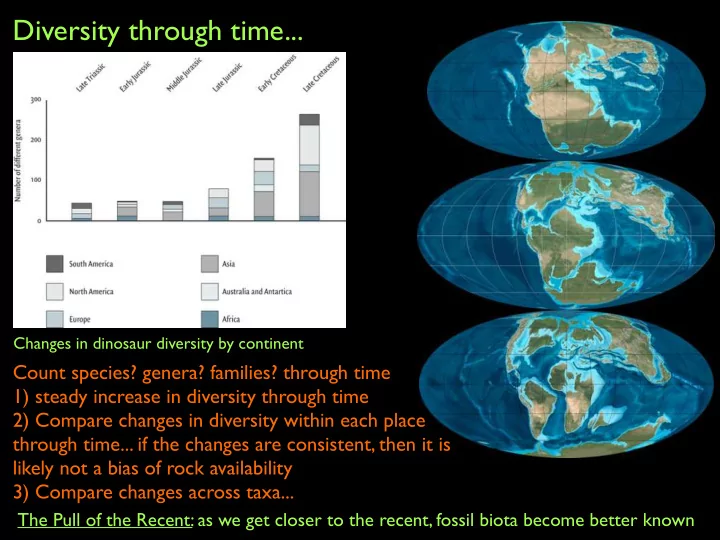

Diversity through time... Changes in dinosaur diversity by continent Count species? genera? families? through time 1) steady increase in diversity through time 2) Compare changes in diversity within each place through time... if the changes are consistent, then it is likely not a bias of rock availability 3) Compare changes across taxa... The Pull of the Recent: as we get closer to the recent, fossil biota become better known
Diversity through time... The Sepkoski Curve
Plant and animal coevolution? Triassic: Lycopods, seed ferns, ferns decrease in abundance Late Triassic, Early Jurassic: gymnosperms increase in abundance Early Cretaceous: Angiosperms undergo an evolutionary burst
We can TEST whether or not Dinosaur herbivores had an exclusive impact on plants evolution... 1) Advanced herbivores (hadrosaurs, pachycephalosaurs, ceratopsians) were Northern Hemisphere animals. 2) The Southern Hemisphere herbivores were mainly sauropods & early ornthipods (unspecialized) 3) Therefore, if derived Dinosaurian herbivore evolution was linked to angiosperm evolution, the evolution of angiosperms should be very different in the Northern Hemisphere. It isn’t.
So, although angiosperm evolution certainly had a large effect on Dinosaur evolution, it is doubtful that Dinosaurs had a global effect on angiosperm evolution
The Crocodylomorph explosion Cretaceous
Terrestrial Crocodylomorphs ‘Rat Croc’ Cretaceous Araripesuchus Skull was about the width of a credit card
Terrestrial Crocodylomorphs ‘Pancake Croc’ mid-late Cretaceous Laganosuchus 20 feet long Jaw was not strong enough to wrestle prey Was a sit-and-wait underwater predator
Terrestrial Crocodylomorphs ‘Dog Croc’ Araripesuchus mid-late Cretaceous Large fore-brain 3 ft long Plant and grub eater
Terrestrial Crocodylomorphs ‘Duck Croc’ Anatosuchus mid-late Cretaceous 2.5 ft long Built to move on land Brain surrounded by air pockets... Specialized nose ~ heightened sensory perception What now Kirk??
Terrestrial Crocodylomorphs ‘Boar Croc’ Kaprosuchus Late Cretaceous 20 ft long Terrestrial 3 sets of caniniform, notched, teeth unique among Crocodiliforms Orbits angled forward (stereoscopic vision) DINOSAUR EATER
The Origin of Mammals Of teeth and ears
The Origin of Mammals Complex ear, jaw joint moves
Mammal Teeth Mammal teeth have complex shapes Different types of teeth in jaws Complex occlusion
Mammal Jaws Early synapsids have lower jaws made up of several dermal bones... In later Therapsids, the tooth- bearing bone (dentary) takes over and all other bones are lost
Mammal Jaws + Breathing • Secondary Palate
Mammal Ears
Reptile/Bird Quadrate-Articular Mammal Ears Probainognathus: beginning of the switch • Expansion of dentary bone Mammal Squamosal-Dentary • Reduction of articular and quadrate bones • First mammals have Dentary-Squamosal articulation • Initially ear bones were still connected to lower jaw: did not move to the inner ear region until later • Modern mammalian ear bones attached to SKULL rather than JAW Evolution
Mammal Ears Intermediates? You want ‘em, we got ‘em
Mammalian locomotion and breathing • Shift breathing contractions from rib muscles to DIAPHRAM • This transition can be tracked by counting ribs
Mammalian Brains
The Origin of Mammals Complex ear, jaw joint moves
The earliest Mammal: Morganucodon • Late Triassic • Small insectivore • Climber, Jumper • True mammal ear but still attached to jaw... not the skull • Upright hindlimb • More than one bone in lower jaw and sprawling forelimbs
The Monotremes • Cretaceous to Recent • Lay eggs! • No breasts; milk oozes from skin • Hair • Ear bones shift from lower jaw to skull during development • Electroreception • Modern forms: • Insectivores Echidna • One species is semi-aquatic • Only poisonous mammal Platypus
The Multituberculates • Jurassic to Eocene • (100 Ma lineage) • Important small herbivores in Cretaceous and Cenozoic • Single bone in lower jaw • Many types of teeth • incisors • premolars • molars • Evidence of hair in the fossil record • Some may have given birth to live young
The Marsupials • Cretaceous to Recent • Live young (embryos) crawl to pouch, attach to nipple and continue development • Share complex molar tooth shape with placentals • Cretaceous forms mostly opossum-like in terms of ecology • Modern forms diverse- peak diversity in Australia and South America
The Placentals • Cretaceous to Recent • Give birth to fully developed young • Fetus nourished by the Placenta • Cretaceous forms were mostly shrew-like in terms of ecology • Modern forms are the dominant group in most ecosystems
Recommend
More recommend